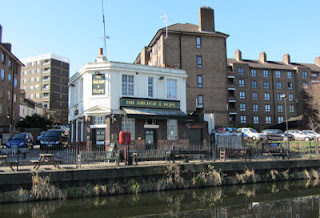 |
| River Lee Weir |
 |
| Housing at Tottenham |
 |
| Anchor and Hope Pub |
 |
| Former Loading Crane |
 |
| Tottenham Lock |
It was over an hour before we arrived at the first lock - Tottenham. The locks on this navigation are mechanised, but later on we will return to a more normal experience! Above the lock there were two large sailing boats - or so they seemed. As we passed them we could see that they were quite new and being used as offices - the first had perhaps 20 desks with the compulsory computers screens whilst the second seemed more for storing clothes. Perhaps they are a design agency?
 |
| Boats as Offices |
For most of the day, the right hand side was a limited view, a string of a dozen reservoirs have embankments well above the normal land level. These provide an important function in the supply of water to London. Of course, the reservoirs only act as a buffer and rainfall is still needed on average at the rate of consumption. All that the reservoirs can do is tide over any short term drought in the long term planning must match demand to supply rather than expecting supply to increase indefinitely to match a growing demand.
At Stonebridge Lock there was a chance to complete the usual services but the water tap, ironically, was very slow and it took some time to fill that tank.
This did give an opportunity to chat to a couple of live-aboards. They both made it clear that they were doing so because more conventional housing was out of their reach. One works in central London and cycles 50 minutes each way. The other works for a charity and has also been involved in the group representing the residential boat owners interests. It is quite possible to see the arguments on both sides but if the present level of mooring is representative, it is less oppressive than on some stretches of narrow canals where a mile of permanently moored non-residential boats demand a slow progress. What did seem unfair, however, is that those moored on private moorings on one side of the canal are paying the proper rate whilst those on the other side are avoiding doing so. time for a more imaginative approach.
 |
| London Waste Incinerator |
A huge waste incinerator dominates the canal above Edmonton but after passing through Pickett's Lock (manually operated) we pulled in to the towpath to moor for lunch. The Lee Valley Park golf course was on the opposite bank.
 |
| Enfield Lock |
Enfield and Ramney Marsh locks both had mechanised bottom gates but the upper gates and paddles all required manual operation with the usual windlass. Just above Enfield Lock there are two terraces of houses called Government Row.
Waltham Town lock is the start of fully manual locks. As we started to work through we were joined by a Canal Chaplain who lives aboard a boat moored just below the lock. He is a reader at the Abbey church and his wife is a funeral director. He was also able to give us directions to the shops which turned out to be reasonably close.
 |
| Waltham Town Lock |
So we moored just above the lock - pretty much as we had expected and set off to town. It is a compact town centre with lots of small shops although 'life style' seems to be a big component: alternative health therapies, hair and beauty salons.
 |
| Waltham Abbey Church |
 |
| Waltham Abbey Main Street |
10.2 miles - 7 locks


No comments:
Post a Comment